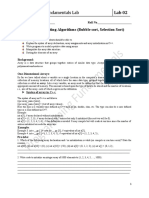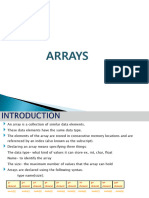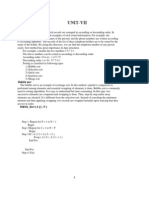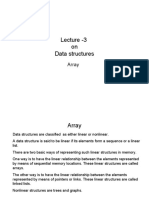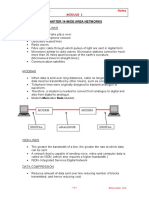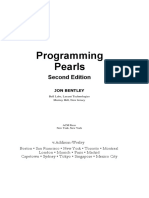Topic: 2.2.2 Arrays: DIM Names (4) As String
Uploaded by
Edzai Nyasha TarupiwaTopic: 2.2.2 Arrays: DIM Names (4) As String
Uploaded by
Edzai Nyasha TarupiwaComputer Science 9608 (Notes)
Chapter: 2.2 Data representation
Topic: 2.2.2 Arrays
An array is a data structure, which allows a set of items of identical data type to be stored together using
the same identifier name.
Arrays are declared in a similar way to standard variables, except that the array size and dimensions are
included. For example, the following declares an array that reserves five locations in memory and labels
these as ‘Names’:
DIM Names(4) As String
The five individual locations are Names(0), Names(1), Names(2), Names(3), Names(4).Each data item is
called an “element” of the array. To reference a particular element a programmermust use the appropriate
U U
index. For example, the following statement assigns data to the 5thelement:
P P
Names(4) = “Johal”
Arrays simplify the processing of similar data. An algorithm for getting five names from the user and
storing them in the array Names is shown below:
Dim Names(4) As String
For i= 0 to 4
Input Value
Names(i)=Value
Next i
One-dimensional arrays
A one-dimensional array is a data structure in which the array is declared using a single index and can be
visually represented as a list.
The following diagram shows the visual representation of the array Names(4):
Page 1 of 7
Computer Science 9608 (Notes)
Chapter: 2.2 Data representation
Topic: 2.2.2 Arrays
Two-dimensional arrays
A two-dimensional array is a data structure in which the array is declared using two indices and can be
visually represented as a table.
The following diagram shows the visual representation of an array Students(4,2):
Each individual element can be referenced by its row and column indices. For example:
Students(0,0) is the data item “JONES”
Students(2,1) is the item “M”
Students(1,2) is the item “LAMBOURNE”
Initializing an array
U
Initializing an array is a procedure in which every value in the array is set with starter values – this starting
value would typically be “” for a string array, or 0 for a numeric array.
Initialization needs to be done to ensure that the array does not contain results from a previous use,
elsewhere in the program.
Algorithm for initializing a one-dimensional numeric array:
DIM TestScores(9) As Integer
DIM Index As Integer
FOR Index = 0 TO 9
TestScores(Index) = 0
NEXT
Page 2 of 7
Computer Science 9608 (Notes)
Chapter: 2.2 Data representation
Topic: 2.2.2 Arrays
Algorithm for initializing a two-dimensional string array:
DIM Students(4,2) As String
DIM RowIndex, ColumnIndexAs Integer
FOR RowIndex = 0 TO 4
FOR ColumnIndex = 0 TO 2
Students(RowIndex,ColumnIndex) = “”
NEXT
NEXT
Serial search on an array
The following pseudo-code can be used to search an array to see if an item X exists:
01 DIM Index As Integer
02 DIM Flag As Boolean
03 Index = 0
04 Flag = False
05 Input X
06 REPEAT
07 IF TheArray(Index) = X THEN
08 Output Index
09 Flag = True
10 END IF
11 Index = Index + 1
12 UNTIL Flag = True OR Index > MaximumSizeOfTheArray
Note that the variable Flag (line 04 and 09) is used to indicate when the item has been found and stop the
loop repeating unnecessarily (line 12 ends the loop if Flag has been set to True).
To complete the search algorithm, some lines should be added, after the loop, to detect the times when
the item X was not found in the array:
13 IF Flag = False THEN
14 Show Message “Item not found”
15 END IF
Page 3 of 7
Computer Science 9608 (Notes)
Chapter: 2.2 Data representation
Topic: 2.2.2 Arrays
Bubble Sort
A bubble sort, a sorting algorithm that continuously steps through a list, swapping items until they appear
in the correct order.
Bubble sort is a simple sorting algorithm that works by repeatedly stepping through the list to be sorted,
comparing each pair and swapping them if they are in the wrong order. The pass through the list is
repeated until no swaps are needed, which indicates that the list is sorted. The algorithm gets its name
from the way larger elements "bubble" to the top of the list. It is a very slow way of sorting data and rarely
used in industry. There are much faster sorting algorithms out there such as insertion sort and quick sort
which you will meet in A2.
For a step by step animation, visit:
http://en.wikipedia.org/wiki/Bubble_sort#mediaviewer/File:Bubble-sort-example-300px.gif
34TU U34T
Step-by-step example
Let us take the array of numbers "5 1 4 2 8", and sort the array from lowest number to greatest number
using bubble sort algorithm. In each step, elements written in bold are being compared.
First Pass:
( 5 1 4 2 8 ) ( 1 5 4 2 8 ), Here, algorithm compares the first two elements, and swaps them since 5 > 1
( 1 5 4 2 8 ) ( 1 4 5 2 8 ), It then compares the second and third items and swaps them since 5 > 4
( 1 4 5 2 8 ) ( 1 4 2 5 8 ), Swap since 5 > 2
( 1 4 2 5 8 ) ( 1 4 2 5 8 ), Now, since these elements are already in order (8 > 5), algorithm does not swap
them.
The algorithm has reached the end of the list of numbers and the largest number, 8, has bubbled to the
top. It now starts again.
Second Pass:
( 1 4 2 5 8 ) ( 1 4 2 5 8 ), no swap needed
( 1 4 2 5 8 ) ( 1 2 4 5 8 ), Swap since 4 > 2
( 1 2 4 5 8 ) ( 1 2 4 5 8 ), no swap needed
( 1 2 4 5 8 ) ( 1 2 4 5 8 ), no swap needed
Now, the array is already sorted, but our algorithm does not know if it is completed. The algorithm needs
one whole pass without any swap to know it is sorted.
Page 4 of 7
Computer Science 9608 (Notes)
Chapter: 2.2 Data representation
Topic: 2.2.2 Arrays
Third Pass:
(12458) (12458)
(12458) (12458)
(12458) (12458)
(12458) (12458)
Finally, the array is sorted, and the algorithm can terminate.
Pseudocode implementation:
The algorithm can be expressed as:
procedurebubbleSort( A : list of sortable items )
32T
do
32T
swapped = false
32T
for eachiin 1 to length(A) - 1 inclusive do:
32T
32Tif A[i-1] > A[i] then
32T swap( A[i-1], A[i] )
32T swapped = true
32Tend if
end for
32T
while swapped
32T
end procedure
32T
Page 5 of 7
Computer Science 9608 (Notes)
Chapter: 2.2 Data representation
Topic: 2.2.2 Arrays
Exercise: Bubble Sort
We will now look at an example in Visual Basic using an array of people's heights. The following data set
is being passed:
height
1 98
2 12
3 99
4 54
36T 36T 10T 10T36 36T 10T 10T36 36T7 10T37
Sub bubbleSort(ByRef height()As integer)
36T 36T 36T 36T7
Dim swapped As Boolean
36T 36T 36T 36T7
Dim temp As integer
12T
'sort the elements
36T
Do
50T 36T50
Swapped = False
36T 36T 50T 43T50 36T4 36T 50T 43T50
For Count =1 To MaxSize-1
36T 36T 10T 10T 50T 43T50 10T43 10T5 50T 10T 10T 10T 10T36
If height(Count +1)< height(Count)Then
50T 50T 10T 10T 10T
Temp = height(Count)
10T 10T 10T 10T5 50T 10T 10T 50T 43T50 10T43
height(Count)= height(Count +1)
10T 10T 50T 43T50 10T43 10T5 50T
height(Count +1)= temp
50T 36T50
swapped = True
36T
EndIf
36T
Next
36T 36T 50T 36T50
Loop Until swapped =False
'Print out the elements
12T
36T 36T 50T 43T50 36T4 36T
For Count =1ToMaxSize
50T 39T50 10T39 10T 50T 48T50 48T50 50T 10T 10T 10T
Console.WriteLine(Count &": "& height(Count))
36T
Next
36T
EndSub
Page 6 of 7
Computer Science 9608 (Notes)
Chapter: 2.2 Data representation
Topic: 2.2.2 Arrays
Linear Search
The following pseudo code describes a typical variant of linear search, where the result of the search is
0T 0T 0T 0T 0T 0T
supposed to be either the location of the list item where the desired value was found; or an invalid
location -1, to indicate that the desired element does not occur in the list.
0T 0T
For each item in the list:
36T 36T 36T 36T
if that item has the desired value,
36T 36T
stop the search and return the item's location.
36T 36T 36T 36T 12T
Return ''-1''
36T 12T36
36T 36T 10T 10T5 10T5 10T48 48T 48T 48T 48T 48T 48T 48T 48T 48T 48T 48T 48T 48T 48T 48T 48T 48T 48T 48T 48T 10T48
dim items() = {"h","g","a","d","w","n","o","q","l","b","c"}
36T 36T 36T 36T7
dim searchItem as string
50T 39T50 10T39 10T48 10T48
console.write("What are you searching for: ")
50T 50T 50T 39T50 10T39
searchItem = console.readline()
36T 36T 50T 43T50 36T4 36T4
For x = 0 to 10
36T 36T 10T 10T 10T 10T5 50T 36T
If items(x) = searchItem Then
50T 39T50 10T39 10T48 48T50 50T 50T 48T50 48T50 50T 10T
console.writeline("Found item " & searchItem & " at position " & x)
36T
Exit For
36T
EndIf
36T 36T 50T 43T50 36T4
If x = 10 Then
50T 39T50 10T39 10T5 43T50 10T43
console.writeline(-1)
36T
EndIf
36T
Next
Page 7 of 7
You might also like
- A Level Computer Science Study Pack 1-1 PDF100% (11)A Level Computer Science Study Pack 1-1 PDF124 pages
- Data Structures & Algorithms: Lecture # 2 Dated: 28-10-2010No ratings yetData Structures & Algorithms: Lecture # 2 Dated: 28-10-201037 pages
- Unit V - Arrays: - Group of Elements of Same Type Is Called ArrayNo ratings yetUnit V - Arrays: - Group of Elements of Same Type Is Called Array56 pages
- 7 Algorithm (Searchinmg & Sorting UPDATED) (MTNo ratings yet7 Algorithm (Searchinmg & Sorting UPDATED) (MT5 pages
- Lec3 Sorting Techniques 16082021 085208amNo ratings yetLec3 Sorting Techniques 16082021 085208am27 pages
- Chapter-2 - Array Searching and SortingNo ratings yetChapter-2 - Array Searching and Sorting21 pages
- Linear Arrays: Memory Representation Traversal Insertion Deletion Linear Search Binary Search Merging 2D Array: Memory RepresentationNo ratings yetLinear Arrays: Memory Representation Traversal Insertion Deletion Linear Search Binary Search Merging 2D Array: Memory Representation34 pages
- Sorting Techniques: Tazeen Muzammil MsseNo ratings yetSorting Techniques: Tazeen Muzammil Msse29 pages
- Chapter - 3 - Searching and Sorting AlgorithmsNo ratings yetChapter - 3 - Searching and Sorting Algorithms22 pages
- A' Level Computing Notes: ©mikey Holder, 2006No ratings yetA' Level Computing Notes: ©mikey Holder, 20063 pages
- Chapter 8-Data Structures and AlgorithmsNo ratings yetChapter 8-Data Structures and Algorithms22 pages
- Zimbabwe School Examinations Council: ComputingNo ratings yetZimbabwe School Examinations Council: Computing33 pages
- Sorting - Algorithm - Python - 1653284600902No ratings yetSorting - Algorithm - Python - 16532846009028 pages
- (Ebook) Computer Programming by E. Balagurusamy ISBN 9789351342939, 935134293X pdf download100% (1)(Ebook) Computer Programming by E. Balagurusamy ISBN 9789351342939, 935134293X pdf download51 pages
- AST20105 Data Structures & Algorithms: Chapter 1 - IntroductoryNo ratings yetAST20105 Data Structures & Algorithms: Chapter 1 - Introductory17 pages
- Introduction to Algorithms 3rd Edition Thomas H. Cormen pdf download100% (1)Introduction to Algorithms 3rd Edition Thomas H. Cormen pdf download50 pages
- Immediate download Problem Solving in Data Structures Algorithms Using C Programming Interview Guide 1st Edition Hemant Jain ebooks 2024100% (1)Immediate download Problem Solving in Data Structures Algorithms Using C Programming Interview Guide 1st Edition Hemant Jain ebooks 202455 pages
- Dharmsinh Desai University, Nadiad: Faculty of Information ScienceNo ratings yetDharmsinh Desai University, Nadiad: Faculty of Information Science39 pages
- Topic-Automatic Sorting Machine EL 2ND SEMNo ratings yetTopic-Automatic Sorting Machine EL 2ND SEM16 pages
- 1 L1 - Introduction To Data Structure and Algorithms100% (1)1 L1 - Introduction To Data Structure and Algorithms96 pages
- Data Structures in Java 1St Edition Oswald Campesato Online Ebook Texxtbook Full Chapter PDF100% (24)Data Structures in Java 1St Edition Oswald Campesato Online Ebook Texxtbook Full Chapter PDF69 pages
- Programming Pearls: Bumper-Sticker Computer ScienceNo ratings yetProgramming Pearls: Bumper-Sticker Computer Science6 pages
- (Ebook) Programming Massively Parallel Processors by Wen-mei W. Hwu, David B. Kirk, Izzat El Hajj, Ph.D. ISBN 9780323912310, 0323912311 download pdf100% (8)(Ebook) Programming Massively Parallel Processors by Wen-mei W. Hwu, David B. Kirk, Izzat El Hajj, Ph.D. ISBN 9780323912310, 0323912311 download pdf71 pages
- Merge Insertion Bubble Linear and Binary SearchNo ratings yetMerge Insertion Bubble Linear and Binary Search73 pages




